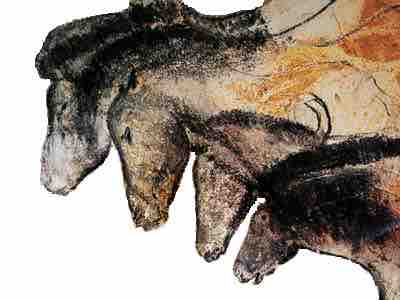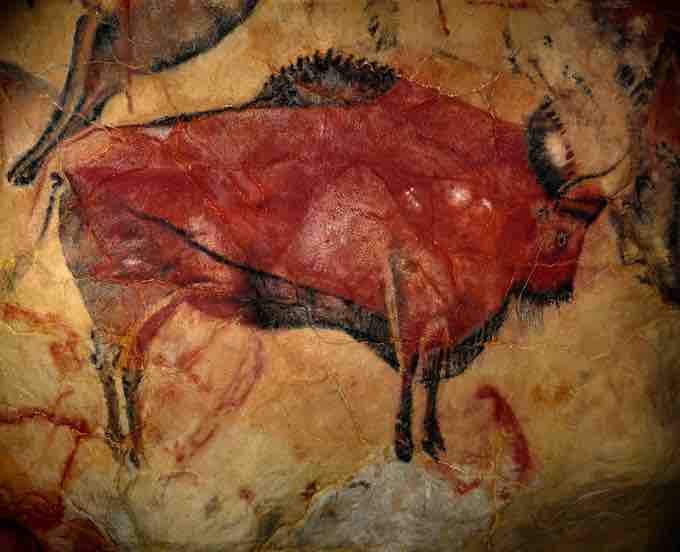The Paleolithic, or Old Stone Age, ranges from 30,000 BCE to 10,000 BCE and produced the first accomplishments in human creativity, preceding the invention of writing. Archeological discoveries across a broad swath of Europe (especially southern France and northern Spain) include over two hundred caves with spectacular paintings, drawings, and sculpture that are among the earliest undisputed examples of representational image-making. Paintings and engravings along the caves' walls and ceilings fall under the category of parietal art.
Themes and Materials
The most common themes in cave paintings are large wild animals, such as bison, horses, aurochs, and deer. Tracings of human hands and hand stencils were also very popular, as well as abstract patterns called finger flutings. The species found most often were suitable for hunting by humans, but were not necessarily the typical prey found in associated bone deposits. For example, the painters of Lascaux, France left mainly reindeer bones, but this species does not appear at all in the cave paintings; equine species are the most common. Drawings of humans were rare and were usually schematic as opposed to the detailed and naturalistic images of animals.
The pigments used appear to be red and yellow ochre, manganese or carbon for black, and china clay for white. Some of the color may have been mixed with fat. The paint was applied by finger, chewed sticks, or fur for brushes. Sometimes the silhouette of the animal was incised in the rock first, and in some caves many of the images were only engraved in this fashion, taking them out of a strict definition of "cave painting."
Main Examples of Cave Paintings: France and Spain
France
Lascaux (circa 15,000 BCE), in southwestern France, is an interconnected series of caves with one of the most impressive examples of artistic creations by Paleolithic humans.

Cave paintings in Lascaux, France
The most famous section of the cave is "The Great Hall of the Bulls," where bulls, equines, and stags are depicted.
Discovered in 1940, the cave contains nearly two thousand figures, which can be grouped into three main categories—animals, human figures, and abstract signs. Over nine hundred images depict animals from the surrounding areas, such as horses, stags, aurochs, bison, lions, bears, and birds—species that would have been hunted and eaten, and those identified as predators. The paintings contain no images of the surrounding landscape or the vegetation of the time.
The Chauvet-Pont-d'Arc Cave (circa 30,000 BCE) in the Ardèche department of southern France contains some of the earliest known paintings, as well as other evidence of Upper Paleolithic life. The Chauvet Cave is uncharacteristically large, and the quality, quantity, and condition of the artwork found on its walls have been called spectacular. Hundreds of animal paintings have been catalogued, depicting at least thirteen different species—not only the familiar herbivores that predominate Paleolithic cave art, but also many predatory animals, such as cave lions, panthers, bears, and cave hyenas.

Drawings of horses from the Chauvet Cave in France
The Chauvet-Pont-d'Arc Cave in the Ardèche department of southern France is a cave that contains some of the earliest known cave paintings.
As is typical of most cave art, there are no paintings of complete human figures in Chauvet. There are a few panels of red ochre hand prints and hand stencils made by spitting pigment over hands pressed against the cave surface. Abstract markings—lines and dots—are found throughout the cave.
The artists who produced these unique paintings used techniques rarely found in other cave art. Many of the paintings appear to have been made after the walls were scraped clear of debris and concretions, leaving a smoother and noticeably lighter area upon which the artists worked. Similarly, a three-dimensional quality and the suggestion of movement are achieved by incising or etching around the outlines of certain figures. The art also includes scenes that were complex for its time—animals interacting with each other. For instance, a pair of wooly rhinoceroses are seen butting horns in an apparent contest for territory or mating rights.
Spain
Altamira (circa 18,000 BCE) is a cave in northern Spain famous for its Upper Paleolithic cave paintings featuring drawings and polychrome rock paintings of wild mammals and human hands. The cave has been declared a World Heritage Site by UNESCO.

Painting of a bison in the Great Hall of Policromes, Altamira, Spain
Altamira's famous Upper Paleolithic cave paintings feature drawings and polychrome rock paintings of wild mammals and human hands.
The long cave consists of a series of twisting passages and chambers. Human occupation was limited to the cave mouth, although paintings were created throughout the length of the cave. The artists used polychromy—charcoal and ochre or haematite—to create the images, often diluting these pigments to produce variations in intensity, creating an impression of chiaroscuro. They also exploited the natural contours in the cave walls to give their subjects a three-dimensional effect.
Interpretations
Like all prehistoric art, the purpose of these paintings remains obscure. In recent years, new research has suggested that the Lascaux paintings may incorporate prehistoric star charts. Some anthropologists and art historians also theorize that the paintings could be an account of past hunting success, or they could represent a mystical ritual to improve future hunting endeavors. An alternative theory, broadly based on ethnographic studies of contemporary hunter-gatherer societies, is that the paintings pertained to shamanism.